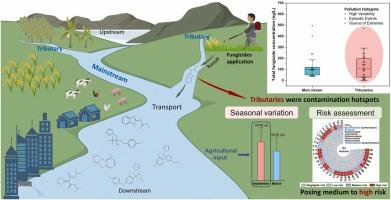东江流域杀菌剂时空变化及风险评价:以支流为污染热点
IF 11.3
1区 环境科学与生态学
Q1 ENGINEERING, ENVIRONMENTAL
引用次数: 0
摘要
尽管大量的研究已经探索了主要河流中的杀菌剂模式,但支流的作用仍然被忽视。以东江干支流为研究对象,研究了7种目标杀菌剂在东江流域的时空分布特征及其生态风险。所有杀菌剂的检出率均为100%,秋季总浓度为7.72 ~ 476.52 ng/L(中位数为106.35 ng/L),春季总浓度为1.86 ~ 501.68 ng/L(中位数为59.91 ng/L)。多菌灵、戊康唑和三环唑为优势杀菌剂。与春季相比,秋季观测到的浓度更高,这是由农业活动增加和降水驱动的径流驱动的。支流杀菌剂浓度普遍高于干流,这主要是由于稀释效应较弱以及靠近集约化耕地,特别是在上游地区。电导率、总磷和土地利用模式等环境因子与杀菌剂分布相关。生态风险评估表明,虽然水生生物的急性毒性风险可以忽略不计,但在大多数采样地点,长期接触多菌灵,特别是多菌灵所造成的慢性风险是显著的。这些结果强调了支流作为污染热点的关键作用,并强调需要更严格的监管政策和改进的农业实践来减轻杀菌剂污染。本文章由计算机程序翻译,如有差异,请以英文原文为准。

Spatiotemporal variations and risk assessment of fungicides in the Dongjiang River Basin: tributaries as contamination hotspots
Although considerable research has explored fungicide patterns in major rivers, the role of tributaries remains overlooked. This study investigated the spatiotemporal distribution, and ecological risks of seven target fungicides in the Dongjiang River Basin of southeastern China, focusing on both the main stream and tributaries. All fungicides were detected in 100% of water samples, with total concentrations ranging from 7.72–476.52 ng/L (median, 106.35 ng/L) in autumn and 1.86–501.68 ng/L (median, 59.91 ng/L) in spring. Carbendazim, tebuconazole, and tricyclazole were the dominant fungicides. Higher concentrations were observed in autumn compared to spring, driven by increased agricultural activity and precipitation-driven runoff. Tributaries generally exhibited higher fungicide concentrations than the main stream, largely due to weaker dilution effects and proximity to intensive cropland use, particularly in upstream regions. Environmental factors such as electrical conductivity, total phosphorus, and land-use patterns correlated with fungicide distribution. Ecological risk assessments indicated that while acute toxic risks to aquatic organisms were negligible, the chronic risks posed by prolonged exposure, particularly to carbendazim, were significant at most sampling locations. These results highlighted the critical role of tributaries as contamination hotspots and emphasized the need for stricter regulatory policies and improved agricultural practices to mitigate fungicide pollution.
求助全文
通过发布文献求助,成功后即可免费获取论文全文。
去求助
来源期刊

Journal of Hazardous Materials
工程技术-工程:环境
CiteScore
25.40
自引率
5.90%
发文量
3059
审稿时长
58 days
期刊介绍:
The Journal of Hazardous Materials serves as a global platform for promoting cutting-edge research in the field of Environmental Science and Engineering. Our publication features a wide range of articles, including full-length research papers, review articles, and perspectives, with the aim of enhancing our understanding of the dangers and risks associated with various materials concerning public health and the environment. It is important to note that the term "environmental contaminants" refers specifically to substances that pose hazardous effects through contamination, while excluding those that do not have such impacts on the environment or human health. Moreover, we emphasize the distinction between wastes and hazardous materials in order to provide further clarity on the scope of the journal. We have a keen interest in exploring specific compounds and microbial agents that have adverse effects on the environment.
 求助内容:
求助内容: 应助结果提醒方式:
应助结果提醒方式:


